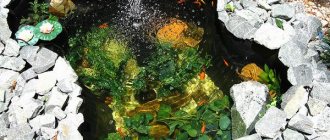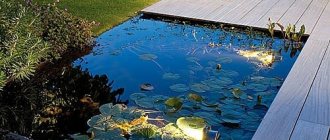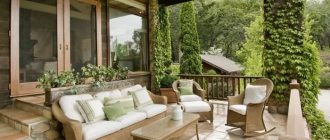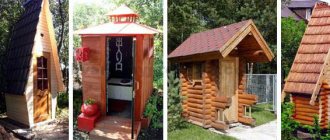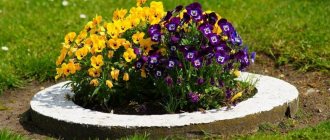Home » Landscape design
Margarita Merkusheva 07/26/2019
4184 Views
How nice it is to enjoy beautiful images of nature and breathe clean air. And there is a wonderful place for this - the dacha. Here you can realize your ideas. One of them is building a pond at the dacha with your own hands. Near such a body of water it will not only be pleasant to relax, but also boldly show off to your guests the masterpiece you created with your own hands. The size of the pond will depend on the free space on the territory, and the arrangement will depend on each person’s personal imagination and financial capabilities.
Film base
Read also: Practical do-it-yourself fencing: installing a chain-link fence (Photo & Video) + Reviews
Film as a base
The use of waterproofing film as a basis provides great opportunities for recreating a reservoir of various shapes, even the most unusual.
PVC film is also not afraid of exposure to ultraviolet rays and temperature changes. Its color lasts for a very long time. The service life is up to 10-15 years.
Butyl rubber film is more reliable. It is more expensive in price. It is used to create deep ponds.
The material is purchased with a reserve (+50 cm on each side) to ensure that its edges are well secured along the banks.
PVC film for pond
The work is carried out in the following order:
- The outlines are marked with lime or sand
- A shallow ditch is dug. Excavated soil is not thrown away
- New outlines are indicated. The bottom should be the deepest
- Using string and measuring tape, calculate the required footage of waterproofing material
- The bottom is covered with a layer of sand. Then non-woven fabric or geotextile is spread to protect the film from possible contact with roots or stones
- The film is spreading. The bottom and ledges are pressed down with pebbles
- The pond is slowly filling with water. It is important that the base material settles gradually
- After 2-3 days, the shores are drawn up. The edges of the cellophane are tucked in. Tiles and stones are placed on top, filling the resulting gaps with sand.
Pond decoration
After installing the pond at the dacha, you can begin to decorate it. Various natural and artificial objects can be used, provided that a single harmonious composition is created. What can be added to a finished pond:
- fish is the best way to enliven the waters of a pond; you can watch the life of fish endlessly;
- aquatic plants - suitable: sedge, reeds, duckweed and other plants growing in the swamp;
- bridge - you can choose any size and design;
- night illumination - enjoying the evening relaxation near a dimly lit pond is unforgettable;
- dishes and interesting artifacts - you can drown an old jug or decorate the shore line with interesting objects
Interesting! The pond and the surrounding area can become a full-fledged place for relaxation with the whole family if you place a bench, garden swing or even a gazebo nearby.
Plants
Plants are an important part of the decorative design of a pond. All plantings that are used in landscape design can be classified into several categories
The choice of suitable plants is made taking into account the given style, climatic conditions and one’s own preferences.
Shallow water
The shallow zone of the artificial reservoir is home to the most moisture-loving plants. Shallow plantings include perennials, which are valued for their picturesque beauty, density and original appearance. Various plantings are suitable for decorating a shallow area - from large plants to textured miniature specimens.
deep sea
Deep-water plantings are rooted at the bottom of the pond, and their leaves reach the surface of the water surface. The advantage of underwater plants with floating leaves is their ability to absorb organic components dissolved in liquid and negatively affecting the ecosystem. Large leaves of deep-sea plantings create shade and prevent strong heating of the liquid, which prevents active growth of algae. Most of the deep-water plantings are distinguished by beautiful flowering.
Coastal
The role of coastal plantings is solely for decoration. Such plants give the pond a complete look and harmoniously fit it into a single style. It is recommended to plant coastal plantings in baskets and dig in along the perimeter. Since plants grow quickly, you should not plant several specimens in one container so that they do not oppress each other.
We outline an action plan
First, let's try to figure out where to place a man-made pond in the country. It is advisable to allocate a place for it at the design stage of a summer cottage.
Photo: marking the area for a decorative pond on the site
Users often search for:
- Rock garden in landscape design
- Fire pit on a summer cottage
The pond must meet the following criteria:
- be in an open place - leaves and branches from trees will clog the water, and roots will damage the artificial bottom of the pond;
- do not be exposed to prolonged exposure to direct sunlight - constantly heated water provokes the rapid development of microorganisms and algae. The pond will quickly become cloudy and begin to emit an unpleasant musty odor.
Photo: a small reservoir on a site with a wooden bridge
It would be useful to provide for the option of expanding the surface of a man-made lake over time. Perhaps you would like to transform the mini-pond into a full-fledged water complex - with a bridge and a small fountain.
Experienced builders recommend making the pond shallow - after all, it is used primarily as a beautiful detail of the surrounding landscape. In addition, immediately think about how you are going to care for the pond. Make a convenient approach to the pond - of course, not through the garden or alpine slides.
You will have to change the water yourself, because it is not purified naturally, like in natural lakes and rivers. Therefore, make sure that the tap at the dacha is located in close proximity to the artificial reservoir.
Types of reservoir
Before you make a pond, you should decide what type it will be. Experts distinguish several types of reservoirs:
- A small pond acts as decoration and complements the landscape design. As a rule, active recreation and a barbecue area are not suitable near such a small pond.
- A fish pond is the best way to replace an aquarium. This type of pond can be made in various shapes and depths. It is worth noting that this pond will need a good system for purifying water and enriching it with oxygen.
- Decorative pond - you can create any shape, the depth should be large, decorated with various elements: a bridge, stones, lighting...
A swimming pond is a pond that differs in size from other types and often requires official permission for its construction. It is worth noting that this type of pond also includes swimming pools.
Choosing a style
A total of two styles are offered:
A regular pond means a structure with clear outlines. If your site is decorated in a modern style, hi-tech, modern or classic, then any geometric: rectangular, round, oval, broken shape will fit perfectly.
Landscape ponds, whose outlines are more natural, that is, irregular in shape, are more popular. You can imagine endlessly here.
Ideas for designing ponds can be found on various thematic websites.
What else is important to consider?
To choose the right style, you need to take into account the topography of the site. On a flat surface, you can choose any shape for the pond. With uneven and uneven soil, additionally equip a cascade or waterfall.
An artificial slide next to all this splendor will also look amazing. In addition, the unevenness of the soil makes it possible to raise the reservoir above the ground.
